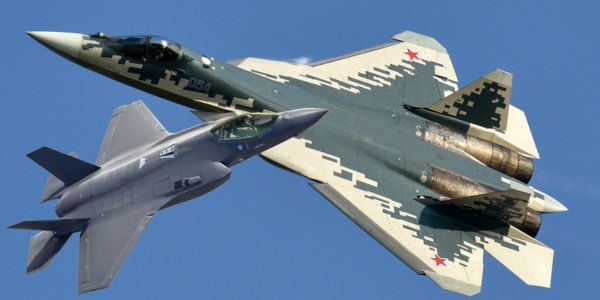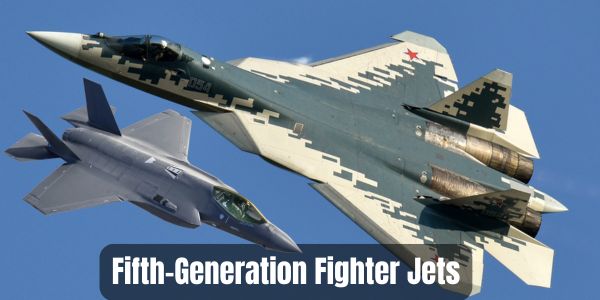In an era defined by high-tech warfare and shifting geopolitical dynamics, fifth-generation fighter jets have emerged as a game-changer in modern aerial combat. Armed with stealth capabilities, cutting-edge avionics, and real-time data fusion, these warplanes represent the pinnacle of air power in the 21st century.
As the United States, China, and Russia field advanced fleets, and countries like India, Turkey, and South Korea push forward with indigenous development, the global race for air dominance is intensifying—reshaping both military strategy and international relations.
What Sets Fifth-Generation Fighter Jets Apart?
Fifth-generation fighter jets are not just faster or more powerful—they’re fundamentally smarter and harder to detect. These aircraft incorporate a suite of breakthrough technologies that distinguish them from earlier generations:
- Stealth Design: Shaped for low observability, fifth-gen jets use radar-absorbing materials and sleek geometries to minimize radar and infrared signatures.
- Supercruise Capability: Unlike previous jets, they can sustain supersonic flight without afterburners, boosting fuel efficiency and mission endurance.
- Sensor Fusion: Advanced onboard systems combine radar, infrared, and external data sources into a single display, enhancing pilot situational awareness and battlefield decision-making.
- Network-Centric Warfare: These aircraft are designed to function as part of a broader digital ecosystem—sharing data with drones, satellites, and ground forces in real time.
- Multi-Role Flexibility: Whether in air-to-air combat, ground attack, or electronic warfare, fifth-gen fighters can adapt to multiple mission profiles with ease.
These capabilities make them vastly more capable than their fourth-generation predecessors like the F-16 or MiG-29, whose aging designs are increasingly outmatched in high-threat environments.

The World’s Leading Fifth-Generation Fighters
United States
F-22 Raptor
Entered service in 2005, the F-22 remains one of the most advanced air superiority fighters ever built. With thrust vectoring engines, stealth optimization, and unmatched agility, the Raptor is nearly invisible to radar. However, its production ended in 2011 after just 187 units due to high costs and export restrictions.
F-35 Lightning II
A family of jets including the F-35A (conventional), F-35B (short takeoff/vertical landing), and F-35C (carrier-based), the Lightning II is the most widely deployed fifth-generation fighter globally. Over 1,000 units have been delivered across NATO and allied nations. Despite facing cost overruns and software issues, the F-35 demonstrated its prowess during Israeli airstrikes in 2024, successfully breaching Iranian air defenses.
China
J-20 Mighty Dragon
Operational since 2017, the twin-engine J-20 serves as China’s flagship stealth fighter. While its radar cross-section is believed to be larger than U.S. counterparts, it has steadily improved in avionics and airframe refinement. With nearly 200 units deployed, the J-20 is a growing presence in the Indo-Pacific region.
J-35
Unveiled in 2024, this carrier-capable fighter is designed to complement the J-20 and enhance China’s naval air power. Still in early deployment stages, the J-35 signals China’s intent to rival U.S. capabilities in multiple theaters.
Russia
Su-57 Felon
Russia’s fifth-generation entry, the Su-57, combines high speed and agility with partial stealth. Although its radar signature is larger than Western stealth fighters, the Su-57 boasts advanced avionics and long-range missiles. As of 2025, limited numbers have been produced due to budget constraints and technical hurdles.
Must Read: Indian Armed Forces Officer Jobs: Ultimate Guide for 2025
Emerging Players and Future Contenders
Several nations are racing to join the fifth-generation club:
- Turkey’s TAI TF Kaan: A prototype flew in 2023 after Ankara was removed from the F-35 program. Turkey is targeting stealth and multi-role capability with international interest, especially from Pakistan.
- India’s HAL AMCA: Expected to enter service in the 2030s, this jet aims to integrate AI, stealth, and even sixth-generation features.
- South Korea’s KF-21 Boramae: Currently considered a 4.5-generation fighter, the KF-21 offers advanced electronics with limited stealth and is seen as a stepping stone toward true fifth-gen capability.
Why Fifth-Generation Fighters Matter
Fifth-gen aircraft are more than tools of warfare—they’re strategic assets that shape national defense and global influence. Here’s why they’re critical:
- Survivability in High-Threat Zones: Their stealth allows them to penetrate airspaces defended by sophisticated systems like Russia’s S-400 or China’s HQ-9.
- Force Multiplier Effect: Acting as digital hubs, these jets share intelligence across the battlefield, enhancing the effectiveness of other platforms.
- Geopolitical Leverage: Nations operating the F-35, for example, enjoy interoperability with U.S. forces but also face dependency on American maintenance and software. This has spurred Europe to accelerate development of its own sixth-generation jet.
- Deterrence Value: The deployment of jets like the J-20 or Su-57 sends a clear message of military capability and intent, especially in contested regions like the South China Sea or Eastern Europe.
Challenges and Criticisms
Despite their advantages, fifth-generation jets come with significant challenges:
- High Costs: The F-35 program has cost over $400 billion, with each jet priced between $80–100 million. Russia’s Su-57 and the U.S. F-22 faced similar budget strains.
- Software Dependence: With so much reliant on advanced code, any software glitch can disrupt operations. The F-35’s development has been plagued by such issues.
- Counter-Stealth Technology: Nations are investing in new radar systems and hypersonic missiles designed to detect and target stealth aircraft.
- Limited Numbers: Only a few countries have deployed fifth-generation fighters at scale. The U.S. Air Force, for example, faces a shortage as older F-15s and F-16s retire faster than new F-35s can be delivered.
Looking Ahead: The Sixth Generation
The limitations of fifth-generation fighters are fueling the development of the next frontier in aerial warfare. Sixth-generation aircraft, expected by the 2030s, will feature:
- Full-spectrum stealth with radar-adaptive materials
- AI-powered autonomy and integration with drone “loyal wingmen”
- Directed-energy weapons such as lasers
- Adaptive engines for superior fuel economy and speed
Major programs like the U.S.’s NGAD (Next Generation Air Dominance), Europe’s FCAS (Future Combat Air System), and China’s rumored J-36 are already in advanced stages of research and testing.
Conclusion
Fifth-generation fighter jets—led by the F-22, F-35, J-20, and Su-57—stand as symbols of national strength and technological dominance. Their ability to operate undetected, make data-driven decisions, and serve across multiple combat roles makes them central to military doctrine today.
Yet their steep costs, software complexity, and emerging countermeasures ensure they are not the end of the evolution. As nations look to sixth-generation designs, the lessons of today’s fighters—about cost, interoperability, and adaptability—will be more important than ever.
Until then, fifth-generation jets remain at the vanguard of aerial warfare, shaping the balance of power in the skies.

